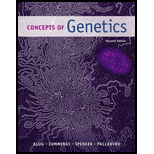
Concept explainers
In a mixed heteropolymer experiment using polynucleotide phosphorylase, 3/4G : 1/4C was used to form the synthetic message. The amino acid composition of the resulting protein was determined to be:

From this information,
- (a) Indicate the percentage (or fraction) of the time each possible codon will occur in the message.
- (b) Determine one consistent codon base composition assignment for the amino acids present.
(a)
To determine: The fraction of the time each possible codon will occur in the message formed in the given experiment.
Introduction: The heteropolymer is made up of two different monomers. The mixture of heteropolymers is used for the process of copolymerization. The amino acids are incorporated in a cell-free protein-synthesizing system in a test-tube. The process begins with a cell-lysate containing all the necessary factors for translation. This method was developed to follow the progress of translation for decoding the genetic code by radioactive labeling of one or more amino acids.
Explanation of Solution
In the given experiment, the amino acids are built from a polynucleotide sequence using only G’s and C’s. The proportion of G is ¾, and C is 1/4. The percentage that each codon will appear depends on its nucleotide proportion.
The fraction for each codon that can occur in the synthetic message is represented as follows:
Thus, the fractions for the possible codons GGG, GGC, GCG, CGG, CCG, CGC, GCC, CCC are 27/64, 9/64, 9/64, 9/64, 3/64, 3/64, 3/64, and 1/64, respectively.
(b)
To determine: One consistent codon base composition assignment for the amino acids present.
Introduction: Codon is a sequence of three nucleotides that corresponds with a specific amino acid or termination signal during translation. DNA and RNA are written in a language of four nucleotides, while the protein language includes 20 amino acids.
Explanation of Solution
In this problem, we are assuming that the genetic code is not known to us. All the given amino acids except the proline are decoded by more than one codon.
Thus, the proline (CCG) is one consistent codon base composition assignment for the amino acids present.
Want to see more full solutions like this?
Chapter 13 Solutions
Concepts of Genetics (11th Edition)
- What are Clathrin coated vesicles and what is their function?arrow_forwardHow is a protein destined for the Endoplasmic Reticulum (ER), imported into the ER? Be concise.arrow_forwardFind out about the organisations and the movements aimed at the conservation of our natural resources. Eg Chipko movement and Greenpeace. Make a project report on such an organisation.arrow_forward
- What are biofertilizers and mention the significancearrow_forwardPCBs and River Otters: Otters in Washington State’s Green-Duwamish River have high levels of polychlorinated biphenyls (PCBs) in their livers. PCBs can bind to the estrogen receptors in animals and disrupt the endocrine system of these otters. The PCBs seem to increase the estrogen to androgen ratio, skewing the ratio toward too much estrogen. How would increased estrogen affect the river otter population? Based on your reading of the materials in this unit, what factors can affect fertility in humans? Explain how each of the factors affecting human fertility that you described can disrupt the human endocrine system to affect reproduction.arrow_forwardOther than oil and alcohol, are there other liquids you could compare to water (that are liquid at room temperature)? How is water unique compared to these other liquids? What follow-up experiment would you like to do, and how would you relate it to your life?arrow_forward
- Selection of Traits What adaptations do scavengers have for locating and feeding on prey? What adaptations do predators have for capturing and consuming prey?arrow_forwardCompetition Between Species What natural processes limit populations from growing too large? What are some resources organisms can compete over in their natural habitat?arrow_forwardSpecies Interactions Explain how predators, prey and scavengers interact. Explain whether predators and scavengers are necessary or beneficial for an ecosystem.arrow_forward
- magine that you are conducting research on fruit type and seed dispersal. You submitted a paper to a peer-reviewed journal that addresses the factors that impact fruit type and seed dispersal mechanisms in plants of Central America. The editor of the journal communicates that your paper may be published if you make ‘minor revisions’ to the document. Describe two characteristics that you would expect in seeds that are dispersed by the wind. Contrast this with what you would expect for seeds that are gathered, buried or eaten by animals, and explain why they are different. (Editor’s note: Providing this information in your discussion will help readers to consider the significance of the research).arrow_forwardWhat is the difference between Uniporters, Symporters and Antiporters? Which of these are examples of active transport?arrow_forwardWhat are coupled transporters?arrow_forward
 Human Heredity: Principles and Issues (MindTap Co...BiologyISBN:9781305251052Author:Michael CummingsPublisher:Cengage Learning
Human Heredity: Principles and Issues (MindTap Co...BiologyISBN:9781305251052Author:Michael CummingsPublisher:Cengage Learning Biology (MindTap Course List)BiologyISBN:9781337392938Author:Eldra Solomon, Charles Martin, Diana W. Martin, Linda R. BergPublisher:Cengage Learning
Biology (MindTap Course List)BiologyISBN:9781337392938Author:Eldra Solomon, Charles Martin, Diana W. Martin, Linda R. BergPublisher:Cengage Learning Biology: The Dynamic Science (MindTap Course List)BiologyISBN:9781305389892Author:Peter J. Russell, Paul E. Hertz, Beverly McMillanPublisher:Cengage Learning
Biology: The Dynamic Science (MindTap Course List)BiologyISBN:9781305389892Author:Peter J. Russell, Paul E. Hertz, Beverly McMillanPublisher:Cengage Learning BiochemistryBiochemistryISBN:9781305577206Author:Reginald H. Garrett, Charles M. GrishamPublisher:Cengage Learning
BiochemistryBiochemistryISBN:9781305577206Author:Reginald H. Garrett, Charles M. GrishamPublisher:Cengage Learning Biology 2eBiologyISBN:9781947172517Author:Matthew Douglas, Jung Choi, Mary Ann ClarkPublisher:OpenStax
Biology 2eBiologyISBN:9781947172517Author:Matthew Douglas, Jung Choi, Mary Ann ClarkPublisher:OpenStax Biology Today and Tomorrow without Physiology (Mi...BiologyISBN:9781305117396Author:Cecie Starr, Christine Evers, Lisa StarrPublisher:Cengage Learning
Biology Today and Tomorrow without Physiology (Mi...BiologyISBN:9781305117396Author:Cecie Starr, Christine Evers, Lisa StarrPublisher:Cengage Learning





